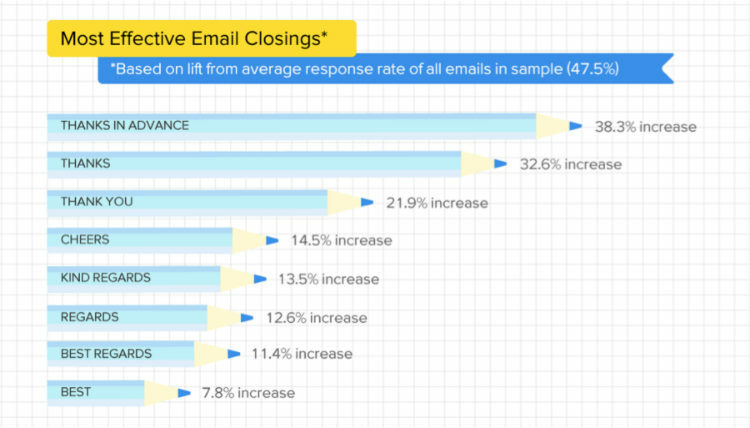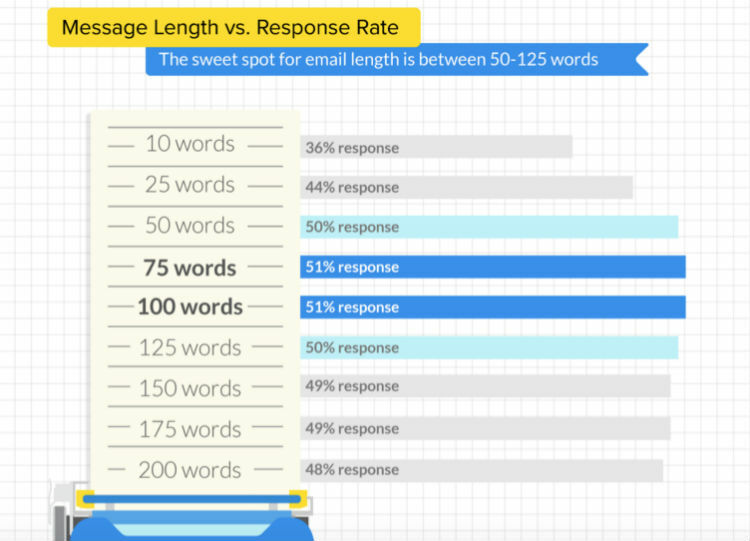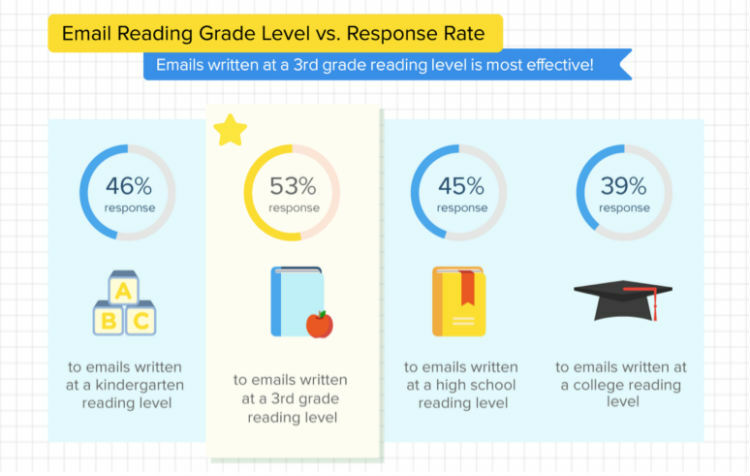Have your email marketing efforts fallen flat?
Do your email messages feel more like messages in a bottle?
Is it possible your subscribers are only sticking around because they don’t want to hurt your feelings?
If any of this sounds familiar, don’t be too hard on yourself.
As you’re about to see, some of the most important techniques for succeeding at email marketing are actually very counterintuitive.
Once you get done reading this post, though, you’ll be ready to put these methods to use right away and turn your email marketing around.
7 Killer Techniques for Your Best Email Marketing
Ready? Let’s dive in!
1. Your Ending Line: Start Strong by Finishing Strong (Better Responses, Proven)
We’re going to start this article with the ending of your email.
You’ve probably heard a million times that you need to begin your emails strong. If your subject line is lacking, interest will be lacking and your email won’t get open.
While subject lines are definitely important (more on that in a moment), it turns out that the way you finish an email plays a significant role in its success, as well.
As you can see from this research provided by Boomerang, this is no small amount, either.
The bottom three options combined weren’t as successful as the top two by themselves.
So if you’re using anything other than “thanks in advance”, you’ll want to change that ASAP.
2. Mondays Are Rough for Everyone, Including Emails

This probably isn’t breaking news to you, but it turns out that Mondays can make people a bit grumpy. They can also make people less receptive to your email.
Therefore, while you may be hoping to catch your readers bright and early before their weeks become overwhelming, you’re actually setting yourself up for failure.
The case against Mondays is expansive.
For one thing, you’re most likely to make errors in your subject lines on Monday.
Not surprisingly, the more errors in your subject line, the less likely your email is to get a response.
According to Boomerang, which looked at 250,000 emails, those with no spelling errors in the topic subject line received a 34% reply rate.
Those that did have errors were responded to 29% of the time.
On average, each error cost the response rate by 14%.
If there’s no way to avoid sending that Monday morning email, at least consider an extra cup of coffee or a second pair of eyes on it before you hit “send.”
3. It Never Fails: Keep Your Emails Short & Simple (But Just How Short?)
Two common mistakes that will hurt your email marketing efforts are to write too much and to opt for longer words when you’re doing it.
The temptation to do these two things is understandable. You want to make sure you give your reader plenty of information or otherwise plead your case.
You also want to come across as a professional, which might seem like a good reason to use longer, more “sophisticated” words.
Here, again, Boomerang’s research is helpful…and surprising.
Keep your emails between 50 and 125 words. Boomerang reported a response rate of at least 50% when writers kept to this length.
As you can see, emails as long as 200 words won’t hurt you too badly.
After that, though, response rates begin tumbling.
Another thing to think about in terms of length is formatting. Remember, a lot of people are going to get your email on their phones. If the words are all crammed together, it’s going to be pretty easy for them to take a pass.
Now, here’s where things get really interesting.
When you think of “authority figure” you probably don’t think of a third-grader, right? Sure, they talk a pretty good game when it comes to their bedtimes, but generally speaking, they’re not the most reliable sources of information.
Well, be that as it may, Boomerang’s research found that writing as a third-grader is best for response rates.
This was by no small amount, either.
If you’ve been doing your best to show readers how smart you are by writing like a valedictorian, you may want to rethink that.
Next time, give your inner-child the keyboard and you could see a 5-10% boost in your response rate!
In case you happened to be an especially advanced third-grader, keep to words with minimal syllables and go with short sentences.
4. Creating the All-Important Subject Line: Best & Worst Words
No article on email marketing would be complete without addressing that most important barrier between you and success: the subject line.
33% of your recipients will decide whether or not to open your email based on the subject line alone.
The first thing you need to know is that three or four words are ideal for email subject lines. Response rates drop by about 2% when you go to the two-to-five range.
After that, though, you’re playing with fire.
This makes sense, of course. 40% of emails are opened on mobile devices. There’s no reason to think this trend is going to reverse, so start shortening those subject lines.
Furthermore, you need to be very careful about the words you decide to use in your subject line.
Years ago, Boomerang did another study. This time they looked at 5,000,000 emails. Here’s what it found were the best and worst words to use in subject lines:
Best Subject Line Words
- Apply
- Cancellation
- Conference
- Connect
- Demo
- Opportunity
- Payments
Worst Subject Line Words
- Assistance
- Confirm
- Invite
- Join
- Press
- Social
- Speaker
Do you see any you’ve been including?
Going forward, avoid those last seven words and look for opportunities to use the other seven instead.
Oh, and if you’re sending out a regular newsletter, find another word. According to research from Adestra, that word will drop your open rate by 11.4% compared to the average.
Here are some other industry-specific words you should stay away from and how badly they affected a message’s chances of getting opened compared to the average:
- Coupon -55.6%
- Available -58.4%
- Coupon -64.0%
- Enclosed -68.9%
- Application -70.4%
- Advance -70.7%
- Free Trial -77.9%
If you want more help crafting great subject lines, check out these 23 examples from HubSpot, and 32 more via Hunter.io.
You should have no problem adopting many of them as they are or just modifying them slightly.
5. Your Email Got Opened! …Now What? A Few Strategies
Getting your email opened is half the battle.
Unfortunately, half the battle isn’t enough to make sales or get responses.
By now, you know to keep your email short and sweet. You even know how to finish strong.
Now all you need to do is get the actual content right.
One of the best ways I’ve found to do this is by speaking to one person at a time.
In other words, I don’t constantly mention my many subscribers or write like I’m talking to a large group.
Instead, I take on a personal tone and talk to one person.
If you’re finding it hard to do this because you have such a large list of diverse subscribers, it might be time to segment.
Otherwise, you could have a million subscribers who all feel like they’re just eavesdropping on a message that was clearly meant for somebody else. Obviously, that’s not what you want.
At the same time, don’t confuse personalizing an email with “talking to a friend.” This advice is often given and then people end up wasting the first two or three lines of an email with the equivalent of small talk.
Remember: short and sweet.
This means getting to the point. Your recipient should immediately see why it’s worth reading the rest of the message. The average 9-to-5 worker spends 28% of their week managing email. Do not give them another reason to delete yours and move on.
7. Simple But Tricky: Only Send Emails That Matter
I know that the furthest thing from your mind would be to commit the gravest of email sins: SPAM (a true four-letter word).
That being said, recipients won’t always consider your intentions when deciding what to do with your message.
If they begin feeling like a number, they probably won’t open your email and will eventually unsubscribe if they are a subscriber.
It gets even worse, though.
According to data from Convince and Convert:
- 21% of email recipients will report a message as SPAM even if they know it’s not
- 43% of recipients decide if a message is SPAM based solely on the “from” name or address they see
- 69% will decide based solely on the subject line
Right away, this should tell you that you need to work extra hard to get recipients to trust you. More than half of them are so sick and tired of SPAM that they’ll report you just for having a questionable subject line.
That’s bad enough all by itself. You could easily waste lots of time and money on emails that your recipients look at and immediately think, “Not a chance.”
Unfortunately, SPAM reports can put your IP address on major blacklists. These lists are then used by email services to keep their account holders safe.
If you end up on even 1 of the 12 major blacklists, your IP address will lose approximately 25 deliverability points compared to those with untarnished records. That major hit is going to hurt your ability to send out large amounts of emails at once.
Aside from making sure you write high-quality emails that follow the above guidelines, you can also prime your IP address prior to sending large batches.
Send smaller batches to people you are relatively confident will open them. This will show ISP filters that your IP address isn’t engaged in producing SPAM emails.
Seven Techniques to Make Email Marketing Simpler
When done right, email marketing can be one of your company’s greatest assets.
You’ll have a list of people you can tap at a moment’s notice for information, polling, and best of all, real sales and ROI.
Now that you’ve read my seven techniques for better email marketing, make the most of this list. Continue to research email marketing and stay ahead of trends to sharpen your skills and adapt to the future.
Categories
Content MarketingCategories
Content MarketingThe Monthly Buzz⚡
Subscribe to BuzzSumo's monthly newsletter to:
Stay up-to-date with the best of the best in content marketing 📝
Get data-informed content, tips and tidbits insights first 👩🏻💻
Read top shared content by top marketing geeks 🤓
Try
Enter any topic, term or url to search to see BuzzSumo in action. It’s free!
100% free. No credit card required.


